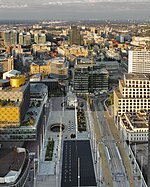Birmingham Repertory Theatre

Birmingham Repertory Theatre, commonly called Birmingham Rep or just The Rep, is a producing theatre based on Centenary Square in Birmingham, England. Founded by Billie Lester , it is the longest-established of Britain's building-based theatre companies and one of its most consistently innovative.Today The Rep produces a wide range of drama in its three auditoria – The House with 825 seats, The Studio with 300 seats and The Door with 140 seats – much of which goes on to tour nationally and internationally. The company retains its commitment to new writing and in the five years to 2013 commissioned and produced 130 new plays.The company's former home, now known as "Old Rep", is still in use as a theatre.
Excerpt from the Wikipedia article Birmingham Repertory Theatre (License: CC BY-SA 3.0, Authors, Images).Birmingham Repertory Theatre
Broad Street, Birmingham Ladywood
Geographical coordinates (GPS) Address External links Nearby Places Show on map
Geographical coordinates (GPS)
| Latitude | Longitude |
|---|---|
| N 52.479417 ° | E -1.909414 ° |
Address
Birmingham Rep
Broad Street
B1 2EP Birmingham, Ladywood
England, United Kingdom
Open on Google Maps










